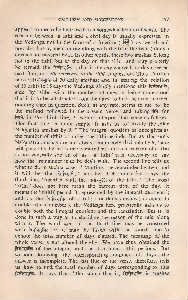Page 705 - Lokmanya Tilak Samagra (khand 2)
P. 705
CRITICISM AND SUGGESTIONS 57
appears to me to be here used in a somewhat technical sense. The
relation between a tithi and a civil day is usually expressed in
the Vedanga not in the form of a fraction ( ~-H) as we should
now do; but by mentioning along with the tithi the two ( daily )
amshas not covered by it. In other words, these two amshas belong
not to the tithi, but to the day on that tithi; and may properly
be termed the ~q-~oq; (that is the day enjoyed, or day covered
parts ) of, or with reference to the tithi in question. Thus 15 tithis
have a~ of 30 daily amshas; and in stating the relation
of 15 tithis to 15 days the Vedanga simply mentions this ~fq-~fui,
side by side with the number of days, it being understood
that it is to be substracted from the days, to find the exact corres-
ponding time in question. Such, at any rate, seems to me to be
the method followed in the present verse; and taking ftM: for
ffi~: in the third line, I would interpret the verse as follows.
The first line is quite simple. It asks us to ' divide the solar
Nak~hatra amshas by 9. " The integral quotient at once gives us
the number of tithis or rather the tithi-periods. But as the sun's
Nak~hatra-amshas are not always completely divisible by 9, there
will generally be left some remainder; and as a fraction of a tithi
is not generally spoken of as ' a tithi ' it is necessary to say
how the remainder is to be dealt with. The second line tells us
what to do in such a case. ' Multiply the remainder by two and
it will be the r~•=ritr~r:ffi, ' not by itself alone but, says the
third line, 'together with the ~q-~Rfi of the tithi. ' The word
' tithi ' does not here mean the current tithi of the day. It
means the ' tithi ( periods ) represented by the integral quotient ';
and as the ~fq-~fu; of a tithi ( in daily amshas ) is equal to
double tithi (number), the Vedanga here practically asks us to
double both the integral quotient and the remainder. But it is
done in such a way as to elucidate the reason of the rule along
with it. The word 'liJ<!S: in the third line may be construed
with f.t:r~fu;: or it may be taken with the fourth line to
denote the total number of days elapsed. The meaning of the
whole verse is not altered thereby. We have thus obtained the
f.t:r'j'q'~ of the integral and the fractional tithi periods. But
without knowing the corresponding number of days the
answer is incomplete. The last line of the verse, therefore, tells
us how to find the total number of days corresponding to this
ko=rfq-~ffli. It says that ' the sum ( that is, ~fq-~ is amshas

